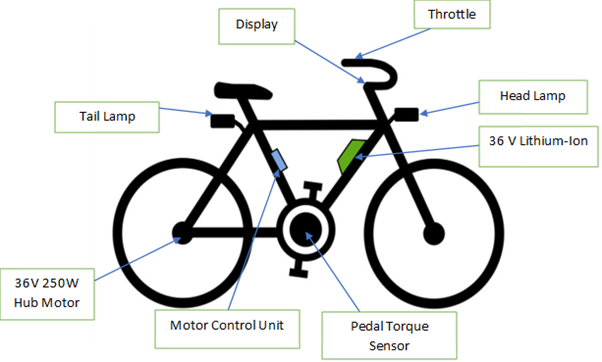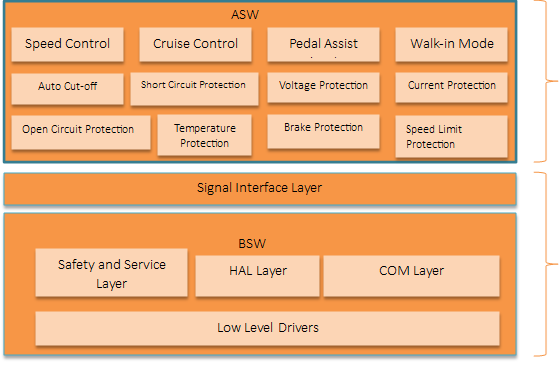- sales@embitel.com
- +91 8041694200
Revolutionizing E-Bicycle Propulsion: Inside Access to BLDC Hub Motor Control Platform
Elevating the efficiency and performance of electric bicycles (e-bikes) to new heights, our BLDC Hub Motor Control Platform stands as a testament to innovation in the realm of 2-wheeler electric propulsion. In this insight, we delve into the intricacies of our platform, showcasing its features, control strategies, and integrated functionalities.
BLDC Hub Motor: Powering the Future of E-Mobility
The Brushless DC (BLDC) hub motor, a cornerstone of our platform, redefines the landscape of electric propulsion. Operating brushless, this motor ensures longevity, low maintenance, and a compact design. Its integrated nature simplifies vehicle structures, offering high efficiency, quiet operation, and precise speed control—making it an ideal choice for e-bicycles.
System Overview
Our platform’s system architecture is meticulously designed, featuring model-based development (MBD) in MATLAB/Simulink. The inclusion of error codes and diagnostic information ensures real-time monitoring and swift responses to potential issues.

Key Features of BLDC Hub Motor:
Brushless Operation: Enhanced efficiency with reduced wear and friction.
Integrated Design: Compact and streamlined, minimizing external complexities.
High Efficiency: Optimal conversion of electrical energy to mechanical energy.
Quiet Operation: Noise reduction for a tranquil riding experience.
Precise Speed Control: Seamless acceleration and deceleration for enhanced control.
Compact and Lightweight: Ideal for applications where weight and space are critical.
Low Maintenance: Longer lifespan and minimal upkeep, thanks to the brushless design.
High Torque to Weight Ratio: Delivering powerful performance in a small, lightweight package.
BLDC Hub Motor Control Platform: Precision in Motion
Our platform offers a comprehensive solution for e-bicycle applications, ranging from 250W to 3kW. Let’s delve into the control algorithm and integrated features shaping the future of electric mobility.
Adding Some Character to the Display
- Battery SOC indicator
- Odometer/ trip meter
- Speed
- Real-time Speed Monitoring: Providing a live display of the current speed, allowing riders to adjust their pace accordingly.
- Speed Modes: Incorporating different speed modes such as eco, normal, and sport, catering to various riding preferences and scenarios.
- Speed Limit Alerts: Notifying riders when they approach or exceed speed limits, ensuring safety and compliance with regulations.
- Speed History Tracking: Logging and displaying past speed data for analysis or performance monitoring purposes.
- Speed Optimization Tips: Offering suggestions or feedback on how riders can optimize their speed for energy efficiency or performance.
- Speed Control Settings: Allowing users to customize speed limits or restrictions based on their skill level or environmental conditions.
- Integration with Navigation Systems: Coordinating with GPS or mapping features to provide speed-related information along with route guidance.
- Speed-Based Rewards or Challenges: Introducing gamification elements where users can earn rewards or compete based on their speed achievements.
- Safety Enhancements: Introducing features like automatic speed reduction in hazardous conditions or when approaching obstacles.
- Social Sharing of Speed Achievements: Enabling riders to share their speed achievements or records with friends or on social media platforms.
- Pedal assist modes
- Modes of cycling (manual/automatic)
The Battery State of Charge (SOC) indicator serves as a pivotal component within our internal electric cycle (e-cycle) project, developed in-house by our company. This indicator plays a crucial role in providing real-time feedback to users regarding the remaining charge level of the battery powering the e-cycle.
By accurately monitoring the SOC, riders can make informed decisions about their travel routes and distances, ensuring they can effectively manage their energy consumption and plan recharging intervals optimally. Through meticulous design and integration, our SOC indicator enhances the user experience, promoting convenience, efficiency, and overall satisfaction with our e-cycle product.
In the realm of electric cycling, the term “odometer/trip meter” refers to a sophisticated instrumentation feature integrated into the e-cycle’s system. Serving as a digital dashboard for riders, this component accurately records and displays crucial metrics related to the distance travelled by the e-cycle. The odometer function provides users with a comprehensive overview of their cumulative mileage, allowing them to track their overall usage and monitor the lifespan of the vehicle.
Additionally, the trip meter aspect offers a more granular perspective by enabling riders to monitor the distance covered within specific trips or journeys. This functionality proves invaluable for both recreational cyclists and commuters alike, as it facilitates precise navigation planning and aids in assessing the efficiency of various routes.
Within the scope of our in-house e-cycle project, the implementation of an advanced odometer/trip meter system underscores our commitment to delivering a seamless and user-centric riding experience. By leveraging cutting-edge technology, we aim to empower cyclists with real-time data insights that enhance their overall satisfaction and promote the widespread adoption of eco-friendly transportation solutions.
“Pedal assist mode” is a cutting-edge display feature designed for our internal e-cycle project. This innovative mode seamlessly integrates the power of our electric motor with the rider’s pedal strokes, enhancing the overall cycling experience.
With pedal assist mode, riders can effortlessly navigate various terrains while conserving energy. This feature not only promotes eco-friendly transportation but also offers users a personalized level of assistance, adjustable to their preferred intensity.
As part of our in-house company project, pedal assist mode reflects our commitment to engineering advanced solutions that prioritize user comfort, sustainability, and performance in every ride.
Experience the freedom to choose your cycling style with our innovative internal e-cycle featuring customizable modes – manual for a traditional biking feel or automatic for effortless cruising. Seamlessly switch between these modes to adapt to any terrain or pace, ensuring an enjoyable ride every time. Whether you prefer the tactile feedback of manual pedalling or the convenience of automatic assistance, our e-cycle caters to your individual preferences, elevating your riding experience to new heights of comfort and convenience
Software Architecture Overview

Control Algorithm: Field-Oriented Control (FOC)
Implementing the sophisticated Field-Oriented Control (FOC), our platform achieves precise control over torque and flux. This control method enhances efficiency and dynamic reactivity, replicating the behavior of a DC motor with advanced transform operations.

Controller Features for E-bicycle Application
Speed Control: Utilizing the FOC algorithm to regulate speeds up to 25 kmph.
Walk-in Mode: Enabling a strolling speed without pedaling, perfect for crowded areas.
Cruise Control: Maintaining a steady speed for a relaxing riding experience on flat terrains.
Pedal Assist Mode: Customizable assistance levels, enhancing user control.
Safety/Protection Features: Incorporating various protections such as short circuit, overcurrent, and temperature control for a secure riding experience.
Family of Microcontrollers Used
To optimize Electronic Control Unit (ECU) functionality, our platform targets the TI C2000 series from Texas Instruments and dsPIC series from Microchip Technology.
The Journey Ahead
As we continue to push the boundaries of e-mobility, our roadmap includes further advancements, exploring newer releases, and expanding our platform to cater to diverse applications within the electric vehicle ecosystem. The BLDC Hub Motor Control Platform stands as a pioneering solution, driving the evolution of electric propulsion in the e-bicycle landscape.


















